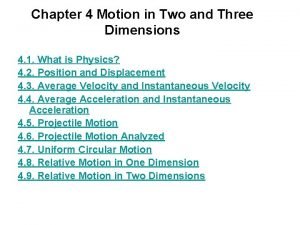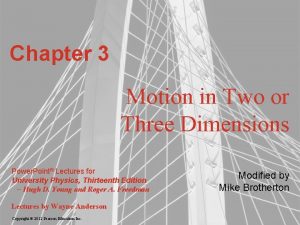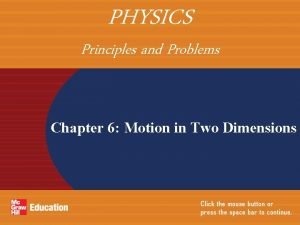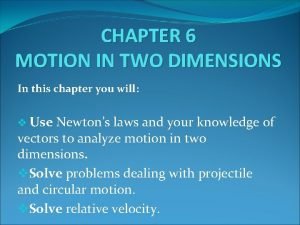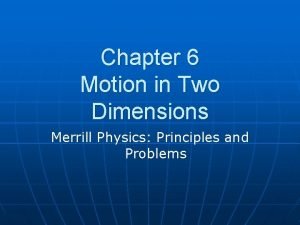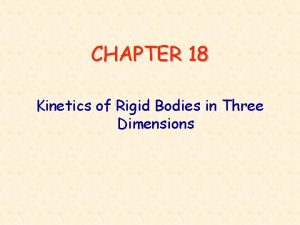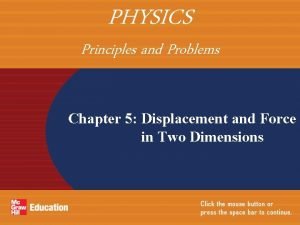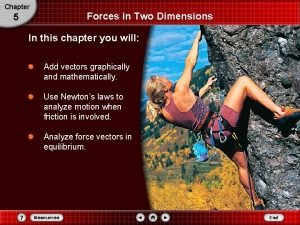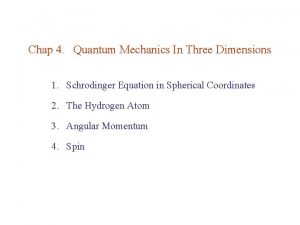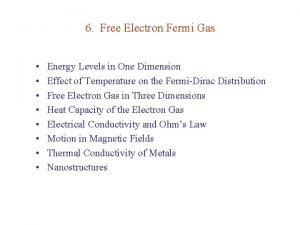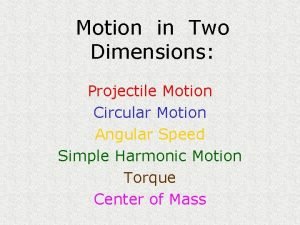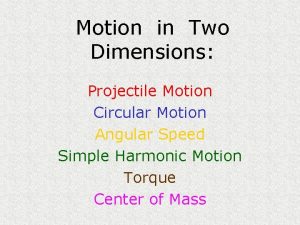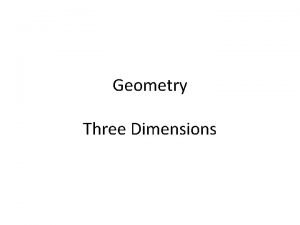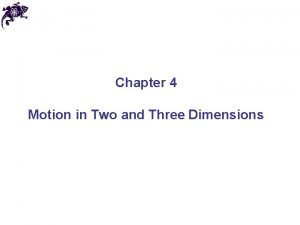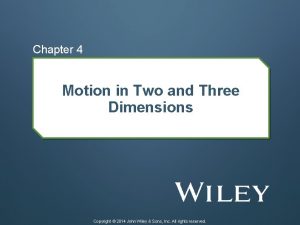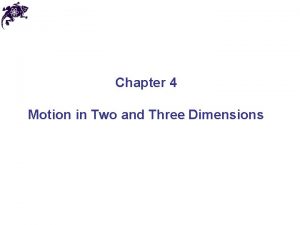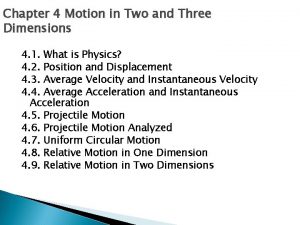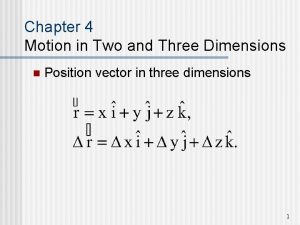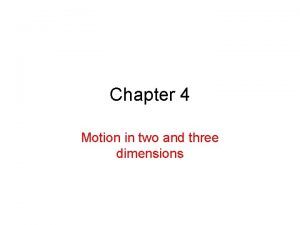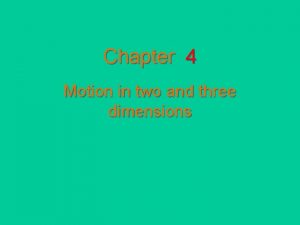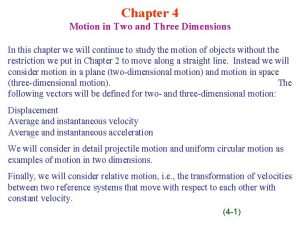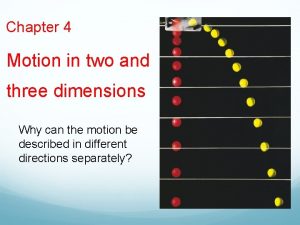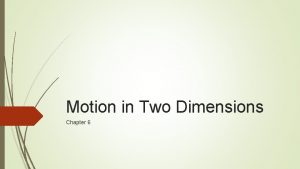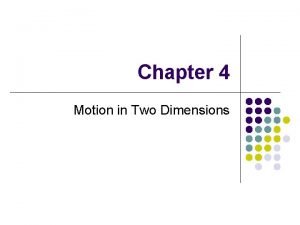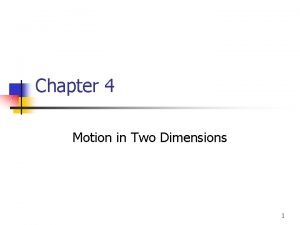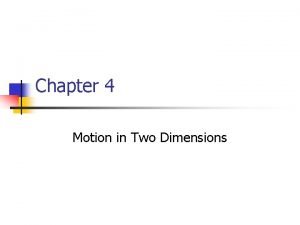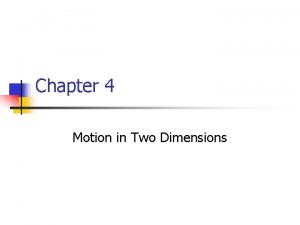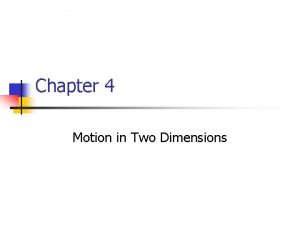Chapter 4 Motion in two and three dimensions





















- Slides: 21

Chapter 4 Motion in two and three dimensions

4. 2 Position and Displacement Position • The position of a particle can be described by a position vector, with respect to a reference origin. Displacement • The displacement of a particle is the change of the position vector during a certain time.

Example: Two-dimensional Motion:

4. 3 Average Velocity and Instantaneous Velocity If a particle moves through a displacement of Dr in Dt time, then the average velocity is: In the limit that the Dt time shrinks to a single point in time, the average velocity is approaches instantaneous velocity. This velocity is the derivative of displacement with respect to time.

Example: Two-dimensional Velocity

4. 4 Average Acceleration and Instantaneous Acceleration Following the same definition as in average velocity: If we shrink Dt to zero, then the average acceleration value approaches to the instant acceleration value, which is the derivative of velocity with respect to time:

4. 4 Two-dimensional acceleration, rabbit run

4. 5 Projectile Motion A particle moves in a vertical plane, with the only acceleration equal to the free fall acceleration, g. Examples in sports: Tennis Baseball Football Lacrosse Racquetball Soccer………….

The initial velocity of the projectile is: Here,

4. 6: Projectile Motion Analyzed, assuming no external forces other than the weight: Vertical Motion; acceleration =g Horizontal Motion: no acceleration Eliminate time, t:

4. 6: Projectile Motion Analyzed: Horizontal Range, assuming no external forces: The horizontal range of a projectile is the horizontal distance when it returns to its launching height The distance equations in the x- and y- directions respectively: Eliminating t:

Example: Projectile Motion:

Example: Projectile Motion:

4. 7 Uniform Circular Motion The speed of the particle is constant A particle travels around a circle/circular arc Uniform circular motion

4. 7 Uniform Circular Motion As the direction of the velocity of the particle changes, there is an acceleration!!! CENTRIPETAL (center-seeking) ACCELERATION Here v is the speed of the particle and r is the radius of the circle.

4. 7 Uniform Circular Motion: Centripetal acceleration, proof of a = v 2/r Note

Sample Problem: Top gun pilots in turns Because we do not know radius R, let’s solve for R from the period equation for R and substitute into th acceleration eqn. Speed v here is the (constant) magnitude of the velocity during the turning. We assume the turn is made with uniform circular motion. Then the pilot’s acceleration is centripetal and has magnitude a given by a =v 2/R. Also, the time required to complete a full circle is the period given by T =2 p. R/v To find the period T of the motion, first note that the final velocity is the reverse of the initial velocity. This means the aircraft leaves on the opposite side of the circle from the initial point and must have completed half a circle in the given 24. 0 s. Thus a full circle would have taken T 48. 0 s. Substituting these values into our equation for a, we find

4. 8 Relative Motion in One Dimension The velocity of a particle depends on the reference frame of whoever is observing the velocity. • • Suppose Alex (A) is at the origin of frame A (as in Fig. 4 -18), watching car P (the “particle”) speed past. Suppose Barbara (B) is at the origin of frame B, and is driving along the highway at constant speed, also watching car P. Suppose that they both measure the position of the car at a given moment. Then: where x. PA is the position of P as measured by A. Consequently, Also, Since v. BA is constant, the last term is zero and we have a. PA = a. PB.

Example: Relative motion, 1 -D:

4. 9 Relative Motion in Two Dimensions A and B, the two observers, are watching P, the moving particle, from their origins of reference. B moves at a constant velocity with respect to A, while the corresponding axes of the two frames remain parallel. r. PA refers to the position of P as observed by A, and so on. From the situation, it is concluded:

Example: Relative Motion, 2 -D airplanes:
 Motion in two and three dimensions
Motion in two and three dimensions Motion in two or three dimensions
Motion in two or three dimensions Physics principles and problems chapter 6 answers
Physics principles and problems chapter 6 answers Rafi is pulling a toy wagon
Rafi is pulling a toy wagon Chapter 6 motion in two dimensions
Chapter 6 motion in two dimensions Chapter 6 motion in two dimensions answer key
Chapter 6 motion in two dimensions answer key Kinetics of rigid bodies
Kinetics of rigid bodies Motion in two dimensions quick check
Motion in two dimensions quick check A cart slows down while moving away from the origin
A cart slows down while moving away from the origin Chapter 5 displacement and force in two dimensions
Chapter 5 displacement and force in two dimensions Chapter 5 study guide forces in two dimensions
Chapter 5 study guide forces in two dimensions Chapter 2 section 1 describing motion answer key
Chapter 2 section 1 describing motion answer key The main difference between speed and velocity involves
The main difference between speed and velocity involves Chapter 2 motion section 1 describing motion answer key
Chapter 2 motion section 1 describing motion answer key Lanczos
Lanczos What is active rom
What is active rom Corporate scope
Corporate scope Horizontal diversification
Horizontal diversification Quantum mechanics in three dimensions
Quantum mechanics in three dimensions Free electron gas model
Free electron gas model Retributive justice
Retributive justice The elements of thought
The elements of thought
